Tips & Advice

The core ingredient
Not all beans are created equal.
It’s impossible to make a balanced third wave specialty espresso using a poor quality bean. The best beans are grown at high altitude in specific microclimates and soils, carefully selected, processed at the origin, and roasted by artisans with lighter roasting profiles.

Know when to grind
When it comes to great coffee, freshness is everything. That’s why you should always use your beans 10-30 days after roasting. Always buy coffee that has a “roasted on date” on the bag, never rely on the “use by date” as a guide to freshness. You may find it difficult to find freshly roasted beans at the grocery store, but your local café should be able to help.
What to look for
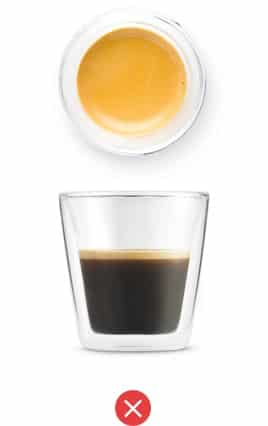
Under Extracted
Taste = Bland
Flow = Fast and pale
Colour = Pale whitish crema
Volume = >40ml in 20 seconds
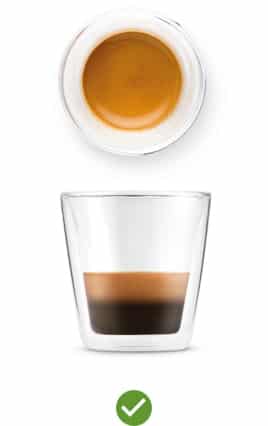
Balanced
Taste = Sweet and creamy
Flow = Thick, warm honey
Colour = Caramelly crema
Volume = 30ml in 20 seconds
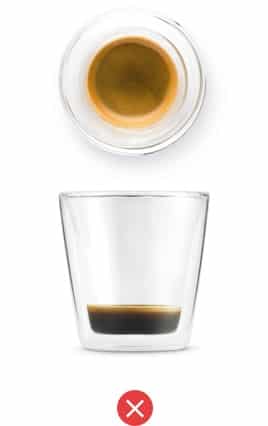
Over Extracted
Taste = Bitter
Flow = Dripping and dark
Colour = Burnt crema
Volume = <20ml in 20 seconds
Milk
Texture is everything
When textured correctly, milk looks like wet, white paint with a consistent texture from top to bottom. Milk when textured correctly, commonly called micro-foam, isn’t just nice to look at, it enhances the taste of the coffee. The thousands of tiny bubbles within the milk entrap the oils of the espresso and burst on the tounge to enhance flavour and mouthfeel.
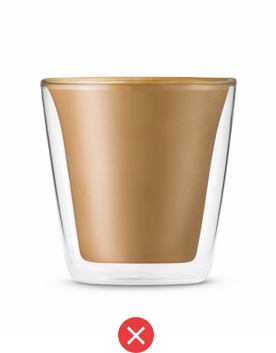
Too Thin
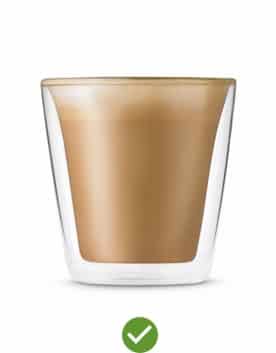
Just right

Too Thick
The crowd favourites
Try creating some of the most popular blends in your own home.

Ristretto
Italian word for “Restricted”
60 – 90ml cup or glass
Instructions
1. Prepare as if mixing a single espresso.
2. Stop extraction at 15 seconds.
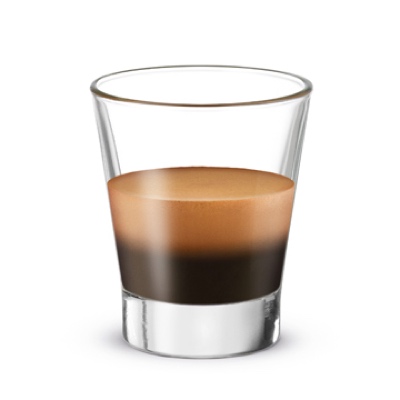
Single Espresso
Sometimes called a “Short Black”
90ml cup or glass
Instructions
1. Approximately 30ml of espresso in 20-25 seconds.
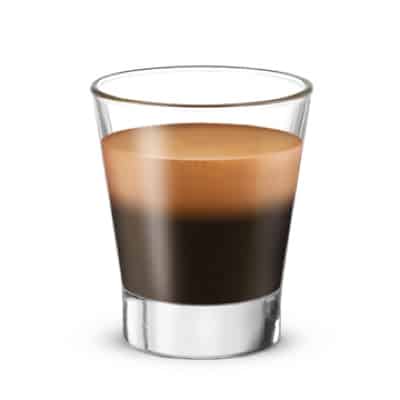
Double Espresso
Sometimes called a “Double Shot”
90ml cup or glass
Instructions
1. Approximately 60ml of espresso in 30-35 seconds.

Long Black
200 – 250ml cup or glass
1 double espresso
Instructions
1. Extract a double espresso.
2. Hot water to fill cup.
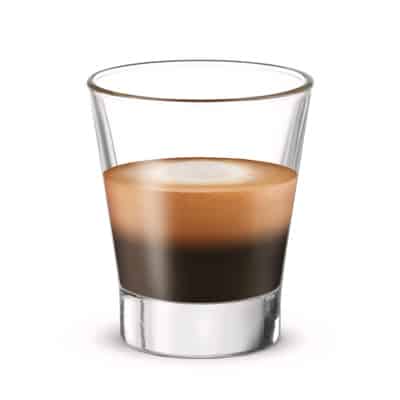
Macchiato
Italian word for “Marked”
60 – 90ml cup or glass
1 single espresso
2 teaspoons textured milk
Instructions
1. Texture the minimum amount of milk you can (just over the white ring) and set aside.
2. Extract a single espresso into a suitable espresso glass or cup.
3. Swirl milk in the jug.
4. Spoon 2 teaspoons of milk into the centre of the espresso.
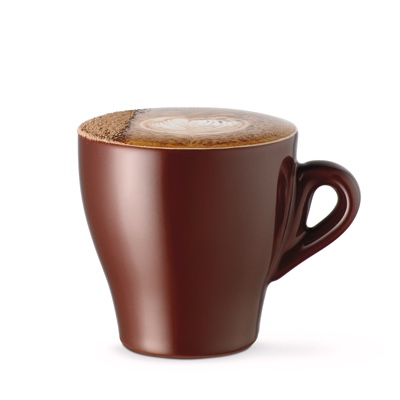
Cappuccino
180 – 220ml cup
1 single espresso
150ml cold milk
Drinking chocolate
Instructions
1. Texture milk to desired temperature.
2. At the same time extract single espresso.
3. Swirl milk in the jug to integrate the texture.
4. Pour milk directly into the centre of the espresso.
5. Hold milk jug tip close to the espresso surface. Steady consistent pour is the secret.
6. Garnish with drinking chocolate.

Latte
200 – 220ml glass
1 single espresso
150ml cold milk
Instructions
1. Texture milk to desired temperature.
2. At the same time extract single espresso.
3. Swirl milk in the jug to integrate the texture.
4. Pour milk directly into the centre of the espresso.
5. Hold milk jug tip close to the espresso surface. Steady consistent pour is the secret.
Add milk
Despite the similarities in ingredients, there are a variety of different styles of coffees created simply by how much milk you use and how it’s prepared.
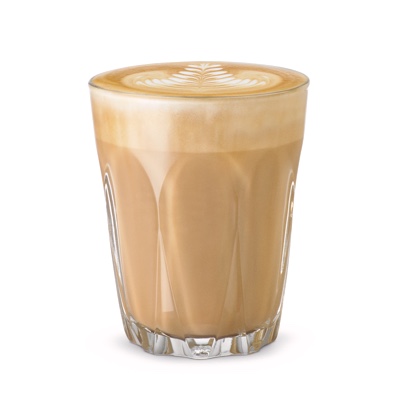
Piccolo
90ml glass
1 single espresso
150ml cold milk
Instructions
1. Texture milk to desired temperature.
2. At the same time extract single espresso.
3. Swirl milk in the jug to integrate the texture.
4. Pour off some milk from the jug into the sink.
5. Pour milk directly into the centre of the espresso.
6. Hold milk jug tip close to the espresso surface. Steady consistent pour is the secret.

Latte
200 – 220ml glass
1 single espresso
150ml cold milk
Instructions
1. Texture milk to desired temperature.
2. At the same time extract single espresso.
3. Swirl milk in the jug to integrate the texture.
4. Pour milk directly into the centre of the espresso.
5. Hold milk jug tip close to the espresso surface. Steady consistent pour is the secret.

Mocha
180 – 220ml glass
1 single espresso
150ml cold milk
Drinking chocolate
Instructions
1. Texture milk to desired temperature.
2. At the same time extract single espresso. Stir 1 tsp. of drinking chocolate into espresso shot.
3. Swirl milk in the jug to integrate the texture.
4. Pour milk directly into the centre of the espresso.
5. Hold milk jug tip close to the espresso surface. Steady consistent pour is the secret.
6. Garnish with drinking chocolate.
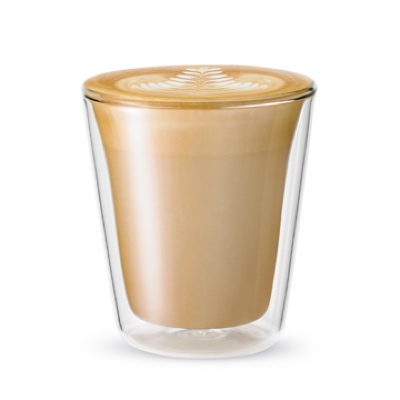
Weak Coffee
200 – 220ml glass
½ single espresso
150ml cold milk
Instructions
1. Texture milk to desired temperature.
2. At the same time extract single espresso.
3. Swirl milk in the jug to integrate the texture.
4. Pour milk directly into the centre of the espresso.
5. Hold milk jug tip close to the espresso surface. Steady consistent pour is the secret.

Strong Coffee
200 – 220ml glass
1 double espresso
150ml cold milk
Instructions
1. Texture milk to desired temperature.
2. At the same time extract single espresso.
3. Swirl milk in the jug to integrate the texture.
4. Pour milk directly into the centre of the espresso.
5. Hold milk jug tip close to the espresso surface. Steady consistent pour is the secret.
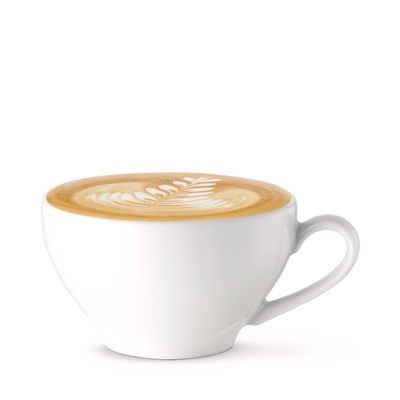
Flat White
180 – 220ml cup
1 single espresso
150ml cold milk
Instructions
1. Texture milk to desired temperature.
2. At the same time extract single espresso.
3. Swirl milk in the jug to integrate the texture.
4. Pour milk directly into the centre of the espresso.
5. Hold milk jug tip close to the espresso surface. Steady consistent pour is the secret.

Cappuccino
180 – 220ml cup
1 single espresso
150ml cold milk
Drinking chocolate
Instructions
1. Texture milk to desired temperature.
2. At the same time extract single espresso.
3. Swirl milk in the jug to integrate the texture.
4. Pour milk directly into the centre of the espresso.
5. Hold milk jug tip close to the espresso surface. Steady consistent pour is the secret.
6. Garnish with drinking chocolate.
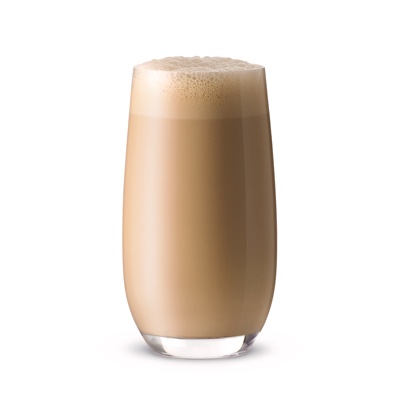
Iced Coffee
200 – 250ml cup or glass
1 double espresso
180ml cold milk
1 scoop ice-cream
1 shot vanilla flavouring
Blender
Instructions
1. Add all the ingredients to a blender and blend on “Smoothie” for 60 seconds.

Affogato
200 – 250ml low profile glass
1 double espresso
1 scoop vanilla ice-cream
Instructions
1. Extract espresso, set aside.
2. Scoop ice-cream into glass.
3. Pour espresso directly over ice-cream.
4. Garnish with chopped pistachios or grated chocolate optional.
Learning the Lingo (Coffee Language)
Because we strive to make things simple, we’ve created a quick list for espresso lingo.
| Acidity
|
Used to describe a range of flavours that are perceived in coffee and can be directly attributed to acids found in the coffee beans. Most people mistake this for bitterness. |
| Aroma | The scents released from brewed coffee, ranging from perfumed, fruity to herbal, as they are inhaled through the nose. |
| Arabica | One of the two main coffee plant species. The other is Robusta. |
| Ashy | Flavour descriptor usually associated with coffee brewed where the water is above the optimum temperature. |
| Americano / Long Black | A style of coffee made by adding hot water to espresso, usually a double espresso together with 200ml of hot water. Italians coined the phrase to describe the coffee preferred by American tourists. |
| Barista | A professional trained in the art of making coffee in a commercial environment to the highest standard. |
| Balanced | Describes the relationship between Acidity, Sweetness & Bitterness. If one or more of these elements dominates the cup, then the coffee is not balanced. |
| Bitter | A harsh, generally unpleasant taste detected mostly in the back of the tongue. Bitterness is characteristic of over-extracted, defective, or extra dark roasted coffees. |
| Blend | Two or more different types of coffee combined together to create synergy with one another when extracted. |
| Body | The physical feel and texture of a coffee. Full-bodied coffees have a strong, creamy, and pleasant taste and feel. |
| Brew Ratio | The amount of ground coffee (g) and brew water (ml) expressed as a ratio when making filter coffee. |
| Bright | Espresso that is overly acidic and usually exhibits citrus flavour notes such as lemon, cumquat, grapefruit etc. |
| Brisbane Latte | A café latte garnished with chocolate on top. |
| C Grade Coffee | Commodity grade coffee that scores lower than Specialty Coffee when cupped (tasted) by a panel of industry experts. |
| Café Latte | A café latte is a single or double shot of espresso combined with textured milk, usually served in a glass ~220ml volume. |
| Café Mocha | This is a variant of a café latte. Like a latte, it is typically one third espresso and two thirds steamed milk, but a portion of chocolate is added, usually in the form of chocolate syrup. |
| Cappuccino | Similar to the café latte, only with more heavily textured milk. Usually a single or double espresso and combined with the textured milk in a 150 – 200ml porcelain cup. |
| Chai Latte | A sweet take on the café latte. A blend of freshly brewed coffee with micro infused milk, mixed with Chai syrup and dusted with cinnamon sugar. |
| Crema | The creamy layer of micro-foam that sits on top of a well-drawn espresso. |
| Cupping | Tasting coffee to assess its quality or potential. Most roasters do this after every roast to ensure quality of their product. |
| Dose | The amount of coffee used when making an espresso or filter coffee. |
| Drip | Short for drip-brewed or filter coffee. |
| ECBC | European Coffee Brewing Center, the peak body in Europe advancing Specialty Coffee. |
| Espresso | In its most basic form, hot water (93°C) delivered under pressure (9 bar) to ground coffee (19g) in a filter basket, supported in a porta-filter, engaged in the group head of an espresso machine, delivering 60ml of liquid (espresso) in approximately 30 seconds once pressure has been applied. |
| Extraction | The process of dissolving soluble flavours from coffee grounds in water. |
| Filter Basket | Holds the compacted ground coffee in place under 9 bars of pressure and allows the hot brew water to flow through the coffee, extracting coffee solids and exiting the fine mesh filter floor of the basket as espresso. |
| Finish | Describes the experience you perceive on your palate after the coffee has been consumed such as, long, short, drying, astringent etc. |
| Flat | Lacking body or texture |
| Flat White | Similar to the cappuccino, only made with milk texture similar to a café latte. Usually a single or double espresso and combined with the textured milk in a 180 – 200ml porcelain cup and without chocolate garnish. |
| Flavour | Usually describes the actual food that most approximates the coffee flavour, blueberry, apricot or even more broadly, stone fruit etc. |
| Fully Washed | Coffee cherries are soaked in large vats of water to soften the pulp before removal. Washing coffee uses large amounts of water, as much as 120ltr to produce 1kg of coffee. Washed coffees are typically clean tasting. |
| Grinding | Crushing/shearing whole bean roasted coffee in order to extract flavour compounds. |
| Macchiato | Meaning “stained”, the macchiato is a single or double shot of espresso with a dash of textured milk layered on top. |
| Mouthfeel | Used to describe the tactile experience of your coffee when consumed, syrupy, thin, full, are terms associated when describing mouthfeel. |
| Natural | A coffee cherry processing method that allows the pulp of the cherry to slightly “rot” a little, making the pulp easier to remove and uses far less water than washing. Natural coffee can taste a little “wild & funky” but also delicious. |
| Porta-filter | This supports the filter basket while engaging with the group head of an espresso machine. An easy way to remember it is to think ‘portable filter’. |
| Pre-Infusion | Gradually increasing water pressure to gently expand grinds for an even extraction by preventing channelling. |
| Pull | To prepare an espresso shot. |
| Roast | Used to describe the colour of the coffee beans after roasting. Light (filter), medium (filter or espresso), dark (espresso), French (very dark). |
| Roasting | The process of applying heat to green coffee in order to change its structure and develop flavour compounds suitable to make coffee beverages. |
| Robusta | Robusta coffee comes from the Coffea canephora plant, a sturdy species of coffee bean with low acidity and high bitterness. Usually used to provide structure to a blend of different coffee beans. |
| SCA | Specialty Coffee Association. The peak body responsible for advancing the development and penetration of Specialty Coffee globally. |
| SCAA | Formerly the Specialty Coffee Association of America, now known as SCA. |
| Shot | Typically 30ml of espresso coffee, including the crema. |
| Specialty Coffee | Coffee that has a score <80 when cupped (tasted) by a panel of industry experts. |
| Steam Wand | The steam wand introduces air, producing thousands of tiny bubbles that turn your milk into a silky smooth micro-foam, essential for latte art, while heating at the same time. |
| Tamping | The action of compressing the ground coffee into the porta-filter with sufficient force to ensure the proper extraction. |
| Taste | Often confused with flavour, taste can only be either salt, sour, sweet, bitter or umami. |
| TDS | The amount of Total Dissolved Solids contained in brewed coffee either filter or espresso when measured with a refractometer. |









